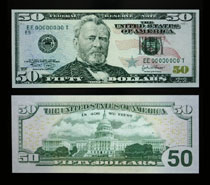當你在美國拿著綠色的鈔票購物時,你想過它的來歷嗎?作為世界第一大國的貨幣,美元有著怎樣的歷史?希望下面的文章中能提供給你滿意的答案。

The origin of the almighty dollar is in what is now the Czech Republic. In 1519, a silver mine near the town of Joachimstal (literally "Joachim's valley," from the German Tal, meaning valley) began minting (鑄造) a silver coin called, unimaginatively, the Joachimstaler. The coin, which was circulated widely, became better known by its clipped form, the taler. In Dutch and Low German, the initial consonant softened to become daler. English adopted this form, eventually changing its spelling to the modern dollar.
In the American colonies, there was no standard currency. The coin that was in widest use was the Spanish Peso, known also as "Pieces of Eight" because it could be divided into eight pie-like pieces. The English colonists informally assigned the name dollar to this coin. In 1785, when the Continental Congress established US currency, they adopted dollar as name for the standard unit of currency, at the suggestion of Gouverneur Morris and Thomas Jefferson, because the term was widely known and was not associated with any form of official English currency. (Jefferson also coined the term disme, from the French dixieme, for a tenth of a dollar. Pronounced deem, it eventually became dime.)
The origin of the $ sign has several folkloric stories attached. One says that Thomas Jefferson invented it, perhaps as a sort of monogram (字母組合) for TS. Jefferson was the first to use the symbol in relation to the US dollar, but this story is fanciful. Another says that originally it was U superimposed over an S, for US of course. Eventually the base of the U eroded due to poor printing technology, leaving an S with two lines through it. Another says that it is a variant of a figure eight that appeared on the Spanish Peso, standing for the pieces of eight. This last is close to the truth, but not quite there.
The Spanish royal family used on its escutcheon, two pillars (representing the Pillars of Hercules in Gibraltar and Morocco) crossed by an unfurled banner reading "Plus Ultra." This symbol appeared on the Peso, and looked much like the modern $ sign. It was adopted as a symbol for the Peso in the American colonies, and was transferred to the dollar.
The US was the first nation to adopt an official currency named the dollar. In 1797, the Bank of England began minting "dollar" coins as bank-issued currency. Other nations that have adopted the name dollar for their currency have done so in emulation of either the US or this short-lived Bank of England practice.
(來源:考試大 實習生朱一楓 英語點津 Annabel 編輯)
我要了解更多趣味百科知識